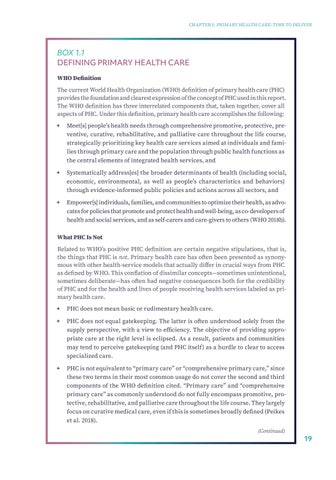CHAPTER 1: PRIMARY HEALTH CARE: TIME TO DELIVER
BOX 1.1 DEFINING PRIMARY HEALTH CARE WHO Definition The current World Health Organization (WHO) definition of primary health care (PHC) provides the foundation and clearest expression of the concept of PHC used in this report. The WHO definition has three interrelated components that, taken together, cover all aspects of PHC. Under this definition, primary health care accomplishes the following: ++ M eet[s] people’s health needs through comprehensive promotive, protective, preventive, curative, rehabilitative, and palliative care throughout the life course, strategically prioritizing key health care services aimed at individuals and families through primary care and the population through public health functions as the central elements of integrated health services, and ++ S ystematically address[es] the broader determinants of health (including social, economic, environmental, as well as people’s characteristics and behaviors) through evidence-informed public policies and actions across all sectors, and ++ E mpower[s] individuals, families, and communities to optimize their health, as advocates for policies that promote and protect health and well-being, as co-developers of health and social services, and as self-carers and care-givers to others (WHO 2018b). What PHC Is Not Related to WHO’s positive PHC definition are certain negative stipulations, that is, the things that PHC is not. Primary health care has often been presented as synonymous with other health-service models that actually differ in crucial ways from PHC as defined by WHO. This conflation of dissimilar concepts—sometimes unintentional, sometimes deliberate—has often had negative consequences both for the credibility of PHC and for the health and lives of people receiving health services labeled as primary health care. ++ PHC does not mean basic or rudimentary health care. ++ P HC does not equal gatekeeping. The latter is often understood solely from the supply perspective, with a view to efficiency. The objective of providing appropriate care at the right level is eclipsed. As a result, patients and communities may tend to perceive gatekeeping (and PHC itself) as a hurdle to clear to access specialized care. ++ P HC is not equivalent to “primary care” or “comprehensive primary care,” since these two terms in their most common usage do not cover the second and third components of the WHO definition cited. “Primary care” and “comprehensive primary care” as commonly understood do not fully encompass promotive, protective, rehabilitative, and palliative care throughout the life course. They largely focus on curative medical care, even if this is sometimes broadly defined (Peikes et al. 2018). (Continued)
19


